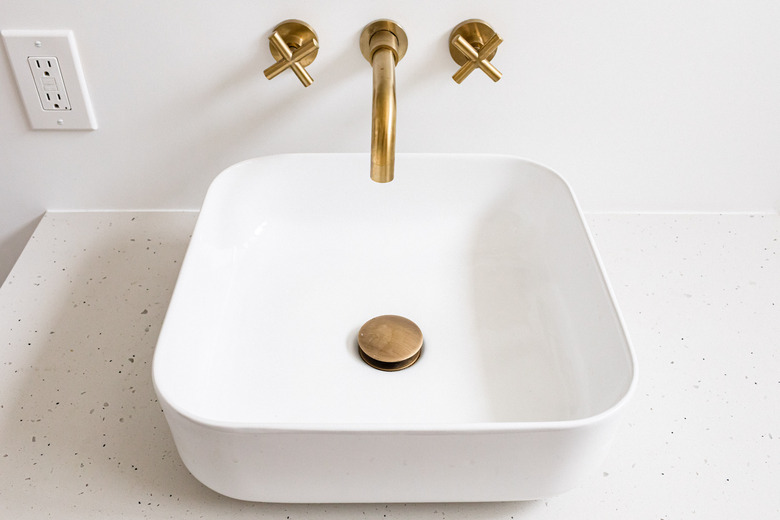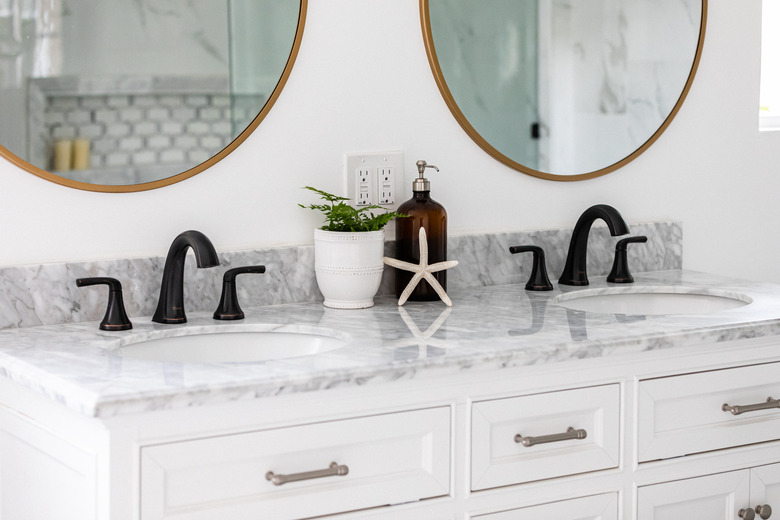Bathroom Sink Sizes And How To Choose One
While bathroom sink sizes vary a bit depending on their shape, they tend to fall within a general size range for each design. It may be tempting to choose a sink based on style alone, but it is important to consider whether the sink will fit into a vanity already in place or if a vessel sink you like will require a new, shorter vanity cabinet and a taller faucet. Pedestal and wall-mount sinks work well for bathrooms that are too small for a conventional vanity with a countertop, while a smaller-than-standard sink may fit the bill for a bath that is barely large enough for both a toilet and sink.
How Bathroom Sinks Are Measured
Measuring your existing sink gives you a better idea of what to look for while shopping as far as sizes that will work well in your bathroom. Sink dimensions are listed in height, width, length and depth.
Sink height is the complete exterior height of the sink from top to bottom at its highest and lowest points. Width (or in some cases, diameter) is the span of the sink exterior from side to side, while length is the exterior measurement from front to back. Kohler defines sink depth as the depth of the sink bowl interior from its lowest point to the bottom edge of the overflow hole (if the sink has one) or to the top of the bowl.
Sink height is especially important if you are considering a vessel sink, as the bowl's height has to work well with the faucet. In many cases, a faucet that is specifically designed for a vessel sink is the best option, as these faucets run 4 to 6 inches taller than standard deck-mounted bathroom faucets.
Once mounted behind the sink, the spout of the faucet should pour water over the bottom of the sink bowl to allow sufficient space to wash hands and to prevent splashing. A faucet that doesn't hang out over the bowl far enough could splash all over, creating a mess. In many cases, vessel sinks do not have faucet holes and pair best with single-hole faucets.
A vessel sink's height also affects the size of vanity that can be used beneath it. A typical vanity countertop sits 32 to 36 inches off the ground, and a drop-in sink's rim sits at roughly the same level as the vanity height. A vessel sink, on the other hand, adds another 6 inches or so to the height, which could prove a bit uncomfortable for hand washing once the sink is mounted atop the average vanity cabinet. In this case, opt for a shorter vanity cabinet so the height of the vanity and vessel sink together rests at 36 inches high or slightly lower.
Before You Go Sink Shopping
Before becoming overwhelmed with the seemingly endless array of bathroom sink sizes, styles and shapes, a few simple considerations will help you narrow down your options. If the bathroom already has a vanity and your goal is to replace the current sink within it, measure the dimensions and the shape of the existing sink as well as the hole that houses the sink in the top of the vanity. Note how the sink drops into the hole as well as the composition of the vanity top.
If the top is stone, for instance, it may be difficult to cut a larger hole to fit a wider sink, but if the top is plastic laminate, it would not be difficult to cut a larger hole to accommodate a larger sink. Also keep the sink bowl shape in mind if you are replacing the sink in a vanity and be sure to opt for a sink of the same size and shape if you don't want to modify the vanity top.
This is also a good time to consider which type of sink best suits the bathroom. For instance, a vanity cabinet housing a drop-in sink offers storage space and countertop space, while pedestal and wall-mount sinks have neither. Wall-mounted sinks (and many pedestal sinks) also require installation between studs, which requires cutting into the wall. These sinks also have exposed plumbing in many cases.
If you are planning to use the new sink with an existing faucet, also note how the faucet mounts. Some sinks have faucet holes, so it is important to pick a faucet that is designed to fit those holes. For a deck- or wall-mounted faucet, the sink should not have faucet holes.
Common Bathroom Sink Sizes
While there is no specific singular size that is standard for all bathroom sinks, most fall into a general size range depending on the type and shape of the sink. For instance, round sinks, including vessel sinks, run 16 to 20 inches in diameter on average, while rectangular or square sinks are a little larger at 19 to 24 inches wide. With rectangular sinks, the sink is usually a couple inches shorter from front to back than its width. For any of these sink shapes, a bowl that holds up to 8 inches of water (the sink depth) is common.
Bathroom sink sizes may also be quite a bit larger or smaller than standard to suit specific needs. For instance, extra-deep sinks offer 12 inches of water depth, while a sink for a tiny bathroom may hold less than 6 inches of water. If you are planning to fit a sink into a vanity of any size, expect to leave 4 to 6 inches minimum countertop space along the sides of the sink. Although the sinks run in standard sizes, a vanity that houses two sinks is a minimum of 60 inches wide, so measure the available bathroom space before choosing this option.

